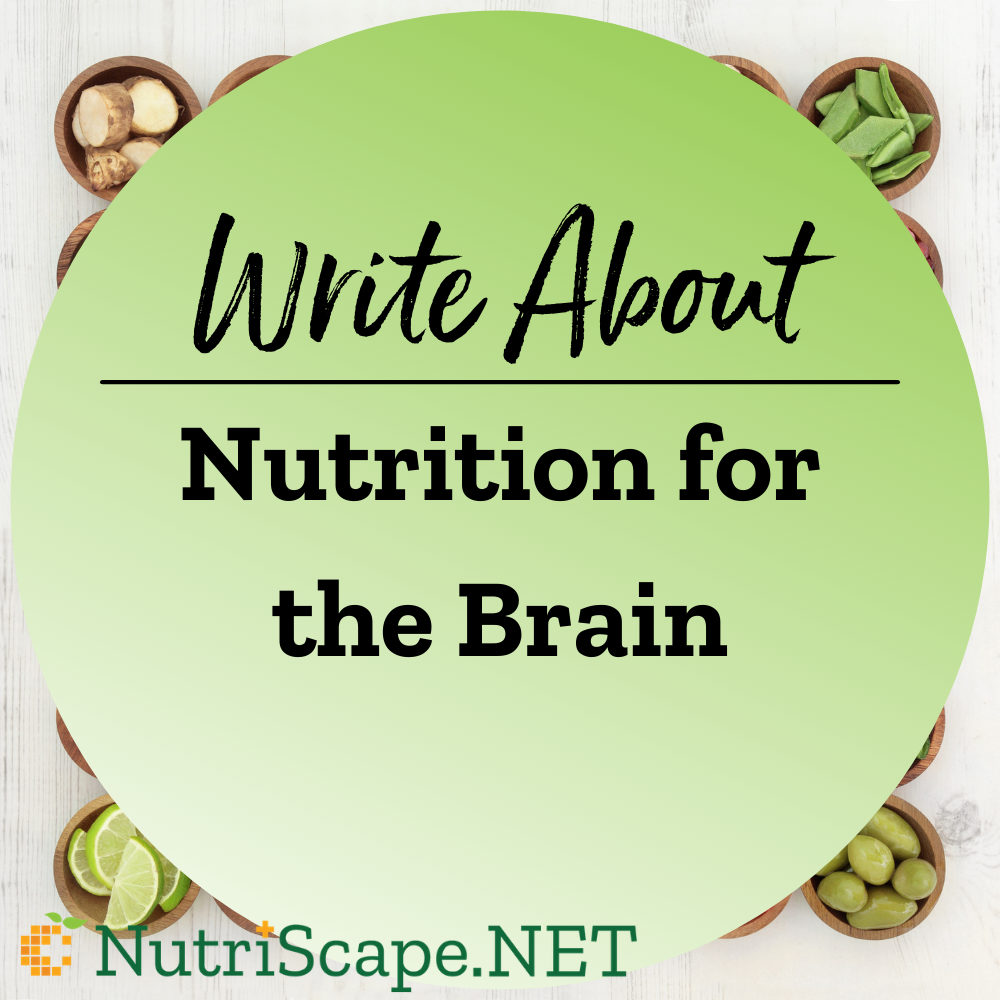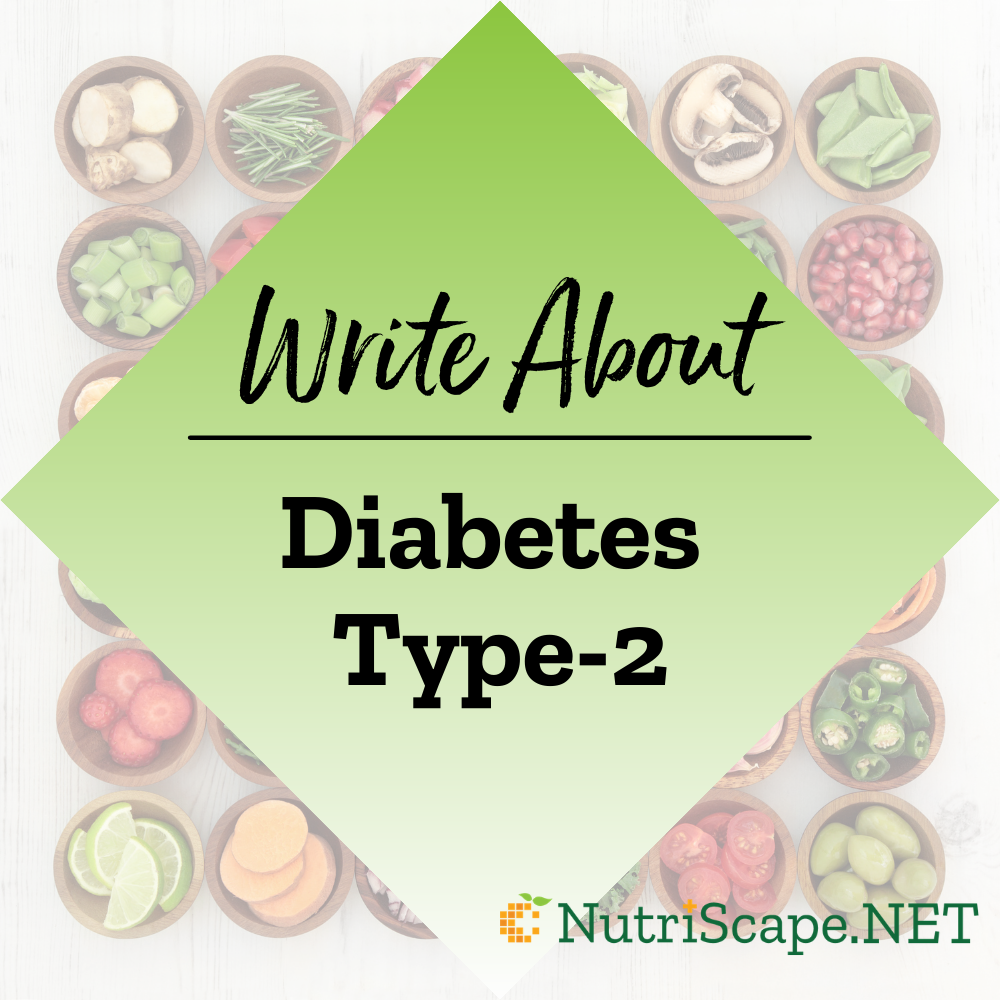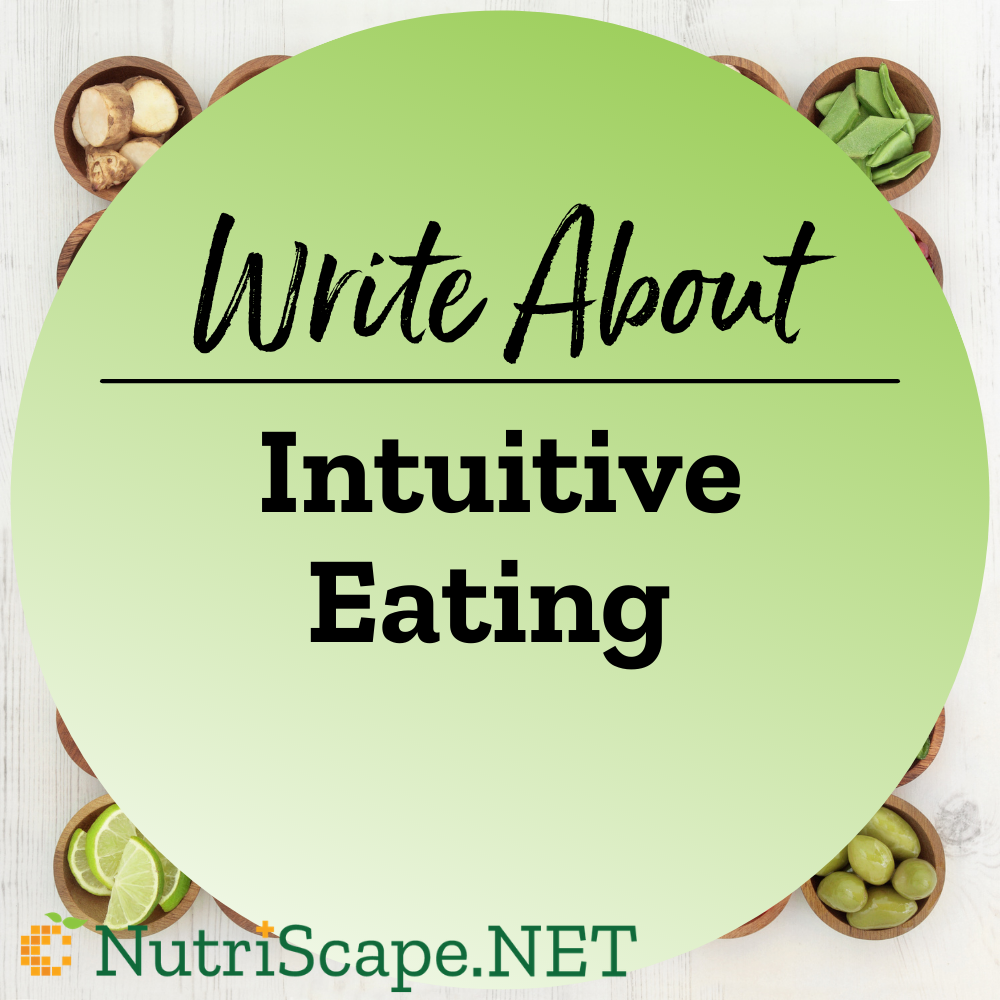
A new study has found that eating nuts on a regular basis strengthens brainwave frequencies associated with cognition, healing, learning, memory and other key brain functions.

A new study has found that eating nuts on a regular basis strengthens brainwave frequencies associated with cognition, healing, learning, memory and other key brain functions.

Eating too fast is linked to obesity and metabolic syndrome, according to a new study. Slow eating, it turns out, is healthier.
Source: Eating Too Quickly Is Linked to Obesity and Metabolic Syndrome | Time
Although all dietitians are well-versed in academic writing, it can be a challenge to organize our vast knowledge in a way that hits the right chord for readers on the web. Before you sit down to write your epic article, save yourself some time by investing an hour in learning the basics of a solid writing process that can help you create your very best work.
We’ve scoured the internet for the best practices on writing and distilled the information to meet the needs of NutriScape writers. In our 1-hour CEU presentation, “Copywriting Skills for the Internet”, we discuss a structured process for each phase of writing and cover critical SEO principles that are key to getting articles found on Google.
This writer’s guide is a resource that will be sure to help as you organize your thoughts:

The winner “by far” was the wild porcini mushroom, which is convenient since it’s also delicious.
Source: Why Mushrooms May Be the Best Food to Help Fight Aging

Among other things, the new tomatoes contain nearly 500 percent more vitamin E than their unenhanced counterparts.
Source: Can Food Stop the Aging Process? Scientists Engineer Tomatoes Designed to Keep You Young
Edit ElementClone ElementAdvanced Element OptionsMoveRemove Element Edit ElementClone ElementAdvanced Element OptionsMoveRemove Element Edit ElementClone
Source: Motivational Interviewing Special Price | RDN Academy
Edit ElementClone ElementAdvanced Element OptionsMoveRemove Element Edit ElementClone ElementAdvanced Element OptionsMoveRemove Element Edit ElementClone
Source: Intuitive Eating | RDN Academy

Bullying and violence at work could increase the risk of developing type 2 diabetes, according to Scandinavian researchers. Men were reported to be 61 per cent more likely to develop type 2 diabetes when exposed to negative workplace behavior, while women had a 36 per cent increased risk.

Source: Can Ginger Help Your Migraine?

Source: Magnesium, magnesium, magnesium!

Source: Biotech firms race to recruit good bugs in war on cancer
Source: Food Protein Induced Enterocolitis Syndrome (FPIES) and Nutrition

Professor Hattori and Professor Kenya Honda of Keio University School of Medicine led research to investigate the relationship between salivary microbes and IBD, and they found that when the bacterium Klebsiella pneumoniae colonizes in an intestine out of microbial balance, immune cells called T helper 1 (TH1) become overactive in the gut, resulting in intestinal inflammation leading to the onset of IBD.

Obesity is often attributed to a simple equation: People are eating too much and exercising too little. But evidence is growing that at least some of the weight gain that plagues modern humans is predetermined. New research from the Research Triangle suggests that variants in a gene called ankyrin-B — carried by millions of Americans — could cause people to put on pounds through no fault of their own.
Source: Gene Prompts Cells to Store Fat, Fueling Obesity | Duke Today
Although all dietitians are well-versed in academic writing, it can be a challenge to organize our vast knowledge in a way that hits the right chord for readers on the web. Before you sit down to write your epic article, save yourself some time by investing an hour in learning the basics of a solid writing process that can help you create your very best work.
We’ve scoured the internet for the best practices on writing and distilled the information to meet the needs of NutriScape writers. In our 1-hour CEU presentation, “Copywriting Skills for the Internet”, we discuss a structured process for each phase of writing and cover critical SEO principles that are key to getting articles found on Google.
This writer’s guide is a resource that will be sure to help as you organize your thoughts:

Parkinson’s – Chew on This. 2.1K likes. Kathrynne Holden, M.S., R.D. (ret) Author, SpeakerNews, tips, and information on nutrition and health as it relates to Parkinson’s disease.

La Jolla Institute for Allergy & Immunology. We have relied on the strength of our people and the quality of our research.

Histamine-releasing factor amplifies food allergies by working in concert with IgE to stimulate the release of histamine from mast cells.
Allergy amplifier implicated in asthma also intensifies food allergy
Tue Nov 14, 2017 4:01 pm (PST) . Posted by: “Kathrynne” homeluvver
Public Release: 13-Nov-2017 Allergy amplifier implicated
in asthma also intensifies food allergy
La Jolla Institute researchers report that inhibitors of
Histamine-Releasing Factor could block inflammatory
response to food allergens
La Jolla Institute for Allergy and Immunology
[IMAGE]
IMAGE: Histamine-releasing factor amplifies food
allergies by working in concert with IgE to stimulate
the release of histamine from mast cells. view
more
Credit: Sciencephoto Library
LA JOLLA, CA–Almost eight percent of children under three
years old and four percent of adults suffer food allergies,
which trigger not only discomfiting symptoms like dermatitis and
diarrhea but can cause deadly anaphylactic shock. Allergic
responses emerge when food components, like egg, shellfish, or
peanut proteins, stimulate white blood cells called mast cells
to dump excessive quantities of histamine or cytokines into the
blood, fomenting inflammation in skin, eyes, or gastrointestinal
tract, among other tissues.
In 2012, LJI researcher Toshiaki Kawakami, M.D., Ph.D.,
reported that a small protein aptly named histamine-releasing
factor (HRF) played a pro-inflammatory role in asthma. His group
now extends that work in the November 13, 2017, online issue of
The Journal of Clinical Investigation by showing that HRF
also serves as a “food allergy amplifier.” The paper reports a
novel biochemical mechanism governing HRF activity, paves the
way for blood tests to predict which patients will respond to
allergy therapy, and strongly supports the idea that drugs
designed to block HRF could prevent food allergy attacks.
Kawakami says that the “prevailing view” of the allergy cascade
is: 1) allergens ramp up levels of antibodies called
immunoglobulin E (or IgE), which then 2) bind to mast cells, and
3) when allergen touches IgE, mast cells release histamine. “But
when we began these studies, we suspected that allergens are
often present at very low levels, possibly too low to activate
mast cells by this pathway,” he says. “Our new paper confirms
that once triggered by allergens, HRF proteins bind to IgE and
then both synergistically activate mast cells and enhance
inflammation.”
To show this, Kawakami’s group engineered mice to become
allergic (“sensitized”) to egg protein and treated them with an
oral HRF inhibitor the lab had developed for use in
asthma-related experiments. To test inhibitor efficacy, they
then re-exposed treated and untreated mice to egg allergens.
As expected, untreated mice developed diarrhea and signs of gut
inflammation. However, these symptoms were delayed or much less
severe in inhibitor-treated mice, and the inhibitor reduced the
allergen reactivity of mast cells isolated from the gut of
allergic mice.
“The fact that orally-administered HRF inhibitors can prevent
development of food allergy in a mouse strongly hints that we
could create similar medicine to treat humans with food
allergy,” says Tomoaki Ando, PhD., the study’s first author and
now an assistant professor at Juntendo University in Tokyo.
Accordingly, the team observed higher than normal levels of IgE
antibodies highly responsive to HRF (what immunologists call
“HRF-reactive IgE”) in the blood of children with egg allergies,
a strong hint that HRF contributes to food allergy in humans
like it does in mice.
The team then monitored those same children as they embarked on
a clinical trial of an anti-allergy procedure called rush oral
immunotherapy (OIT), in which patients consume increasing
amounts of egg several times daily over a few weeks. Once
patients achieve desensitization, they keep consuming eggs for
12 months of maintenance period. And then, egg products are
withdrawn for two weeks before re-exposure to egg protein, as a
test of the therapy’s durability.
A key finding in the paper is that children who successfully
met this last “challenge”–that is, remained unfazed by egg
consumption two weeks after cessation of therapy–maintained low
blood levels of HRF-reactive IgE after OIT. In contrast,
children who became re-sensitized to egg proteins immediately
after OIT interruption observed an increase of HRF-reactive IgE
during maintenance period.
Ando sees the association of HRF-reactive IgE increase with OIT
failure as a positive outcome in terms of drug discovery, as it
reveals HRF to be a target potentially druggable by inhibitors
effective in animal models. “In fact, if a patient’s allergy
remained unchecked independent of HRF levels, that might mean
that their condition is going to be more difficult to treat,” he
says. “These tests also warrant future clinical monitoring of
HRF-reactive IgE levels as a predictor of OIT results.”
Kawakami’s lab remains focused on developing potent HRF
inhibitors and is currently testing them using mouse models
described in this study. His goal is to decrease patients’ risk
of allergic shock, so they can enjoy the simple pleasures of a
normal life, like going out to eat.
“I hope to see protection for patients who go to a restaurant
and don’t know what ingredients are in the food,” says Kawakami,
a professor in LJI’s Division of Cellular Biology. “In the
future, they might take an oral inhibitor as a preventive
measure. Our biggest concern for these individuals remains
anaphylaxis–it’s potentially lethal.”
###
The study was funded by grants from the National Institutes of
Health (HL124283, AR064418, AI115534 and AI124734), the Ministry
of Education, Culture, Sports, Science and Technology, Japan
(25670483, 26860765, 15K10794), the Japan Research Foundation
for Clinical Pharmacology, and the Nipponham Foundation for the
Future of Food.
Full citation: “Histamine-releasing factor as a food
allergy amplifier”, Tomoaki Ando, Jun-ichi Kashiwakura,
Naoka Itoh-Nagato, Hirotaka Yama****a, Minato Baba, Yu
Kawakami, Shih Han Tsai, Naoki Inagaki, Kiyoshi Takeda,
Tsutomu Iwata, Naoki Shimojo, Takao Fujisawa, Mizuho
Nagao, Kenji Matsumoto, Yuko Kawakami, and Toshiaki
Kawakami, Journal of Clinical Investigation (2017).
About the La Jolla Institute for Allergy and Immunology
The La Jolla Institute for Allergy and Immunology is dedicated
to understanding the intricacies and power of the immune system
to that we may apply that knowledge to promote human health and
prevent a wide range of human diseases. Since its founding in
1988 as an independent, nonprofit research organization, the
Institute has made numerous advanced leading toward its goal:
life without disease.

A 10-month-old Mexican baby weighs the same as an average 9-year-old child. Doctors say the baby may be suffering from a genetic condition called Prader-Willi syndrome.

The terms allergy and food intolerance are used interchangeably, but is a cheese-induced stomach ache the same as a life-threatening reaction to peanuts?
Source: Allergy, intolerance or food sensitivity: what’s the difference?

A team of Massachusetts General Hospital investigators has found a possible mechanism explaining why use of the sugar substitute aspartame might not promote weight loss.

Many experts are concerned about people attempting the diet.
Source: Most popular weight-loss diet on Reddit would never be recommended by nutritionists | Fox News

Increases patient engagement, yields better health outcomes
Source: App Improves Quality of Life in IBD Patients | Medpage Today

Free 4 week online courses – Mindfulness for Women Who Struggle With Weight, #BeHerNow to Stop Waiting and Start Living, and Overcoming Feelings of Food Addiction
Articles related to general nutrition at different stages in life.

A reader asks whether washing fruits and vegetables does the trick in eliminating your exposure.
Source: Ask Well: Washing Off the Pesticides – The New York Times

Some pesticides are actually designed to be absorbed into the tissue of the fruit or vegetable to protect it from pests
Source: Do Pesticides Get Into the Flesh of Fruits and Vegetables? – The New York Times

Centers for Disease Control and Prevention (CDC) Division of Diabetes Translation (DDT) Diabetes Prevention Recognition Program (DPRP) Application and Registry
Source: DCE Webinars

Association leveled off at capacity of 15 mmol/day
Source: Antioxidants May Help Stave off Type 2 Diabetes | Medpage Today

The purpose of this study was to conduct a meta-analysis of randomized controlledtrials (RCTs) to assess the effect of green tea on serum leptin and ghrelin concentrations.
In this episode, I answer a listener’s question about whether I am worried about my phosphorus intake and whether a high phosphorus intake is ok as long as it is balanced by calcium. I describe the biochemistry and physiology of the system that regulates calcium and phosphorus, their distribution in foods, how to determine the […]
In this episode, I discuss dietary management of familial hypercholesterolemia (HeFH). This question was asked on the Facebook Live episode from 06/16/2016, “Ask Chris Masterjohn, PhD Anything About Heart Disease,” but I was unable to get to the question within Facebook’s time limit. Please note that HeFH is a medical issue and the purpose of […]

In this episode, I tell the story of my own battle with eczema. I begin by describing my extraordinary recovery from extreme eczema using the right probiotic. I then describe how a more recent relapse led me to discover the incredible importance of mitigating soap exposure when gut-related approaches don’t seem to work. Listen on […]
Did you know that adding MCT oil to your pasta is more ketogenic than restricting your carbohydrates to ten percent of calories? Many people think of carbohydrate and insulin as central to ketogenesis, but the direct biochemical event that initiates ketone formation is actually the oversupply of acetyl groups to the TCA cycle during conditions […]
Glutathione is central to recovery from exercise, feeling good, looking good, aging gracefully, and preventing or overcoming both infectious diseases and chronic degenerative diseases. Episode 31 covers everything you need to know about why and how to manage your glutathione status. Listen on ITunes or Stitcher. Click here to stream. Right-click (control-click on the Mac) […]
Source: Why You Should Manage Your Glutathione Status and How to Do It | Chris Masterjohn, PhD
In this special interlude, I lay down the framework of the five core principles that make a good marker of nutritional status. This is to lay down the framework for a series of podcasts in the future about managing nutritional status for specific vitamins and minerals. Since these core principles will be referred back to […]
Source: What Makes a Good Marker of Nutritional Status? | Chris Masterjohn, PhD

Listen in for blood tests, genetic tests, and practical strategies to optimize iron status.
Source: Why You Need to Manage Your Iron Status and How to Do It | Chris Masterjohn, PhD

Foods, supplements, blood tests: everything you need to know about copper to maintain vibrant health.
Source: Why You Should Manage Your Copper Status and How to Do It

Why Stephan wrote the book, what you can get out of it, and practical advice for everything ranging from losing weight to writing a book. Listen in!
Source: Stephan Guyenet and Chris Masterjohn Talk About “The Hungry Brain”